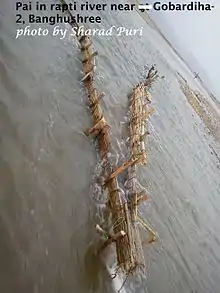Pai (fish trap)
Pai (पाई)[1] or sometimes called Pahi (पाही) is a fish trap constructed by using Thakal daantha (थाकलकॊ डाॅठ) and Beshram (बेश्रम)/byaye (व्याय)/ajambari (अजम्बरी) thoroughly knitting with rope to make large rectangular sheets suitable for the filtration of water which is mainly famous in Tharu,[2][3] Kumal [4] and Majhi[5] communities of western Nepal. Knitted sheets of their desired length and width are fixed in river of sharp current with the help of strong and large wooden nails (Kila). This fish trap was very efficient and logical tool for the ancient indigenous peoples which helped them to become successful. Today, these ancient techniques are becoming a good source of income for the people there. This fish trap looks like Greek symbol pi(Π). Indigenous peoples from near around villages of banghushree are still adopting this technique for fishing in West Rapti River.
Methods
The method using for this fish trap is filtration where fishes are considered as suspended solids, rectangular knitted sheets acts as a filter, large wooden nails as a rigid support for entire system. This method for fishing is only applicable for rivers which are free from derbies and other suspended objects.
Images
Captured by Sharad Puri, Dang

.jpg.webp)